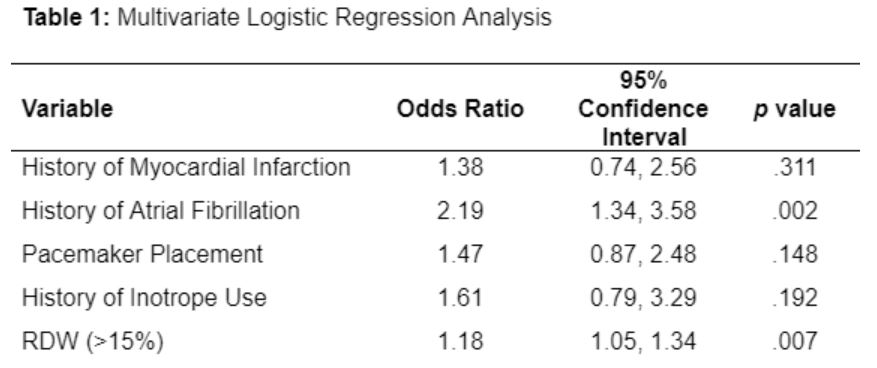 Low-Cost Predictor for 1-Year Heart Failure Readmission
Low-Cost Predictor for 1-Year Heart Failure Readmission
Author: Damian Valencia, MD, Additional Authors**
See the poster presentation | See the poster
Background
Heart failure exacerbation is a leading cause of hospitalization, morbidity and mortality in the United States. Readmission rates are high, leading to increased health care utilization and poor patient outcomes. Early risk stratification may guide clinicians towards patients who require closer outpatient follow up, thereby reducing overall readmission rates and improving patient outcomes.
Objective
The aim of this study was to determine if a low-cost reliable predictor for heart failure readmission at one year was present at the time of index hospitalization.
Methods
This was a retrospective analysis of 329 adult patients admitted for acute heart failure exacerbation at our institution (Kettering Health, Main Campus. Dayton, OH.). Patients with Hemoglobin <10 g/dL, recent acute coronary syndrome (within 3 months), recent transfusion (within 3 months), sepsis and malignancy were excluded. Univariate analysis was used to compare baseline characteristics [age, gender, body mass index (BMI), history of myocardial infarction, history of atrial fibrillation, left ventricular ejection fraction, mitral regurgitation, right ventricular dysfunction, aortic stenosis, type 2 diabetes mellitus, smoking history, alcohol use, creatinine, albumin, pacemaker placement, history of previous inotrope use and red cell distribution width (RDW)] between two patient groups (readmitted and non-readmitted at one year). Continuous variables were not normally distributed (Shapiro-Wilk test p<0.05), requiring non-parametric Mann-Whitney U tests to compare continuous baseline characteristics between groups. Nominal characteristics were compared using the Pearson’s chi-squared test. Variables which were significant in univariate analyses were used as predictors in multivariate logistic regression modeling. Alpha was set to 0.05, two-tailed, for all analyses. Variance inflation factors were assessed to evaluate the potential for multicollinearity between predictors in order to assure that all variance inflation factors were within acceptable ranges (<5.0).
Results
There was an increased incidence of atrial fibrillation, pacemaker placement , history of previous inotrope use, history of myocardial infarction and RDW ≥15% amongst patients readmitted within one year. On multivariate logistic regression analysis, any history of atrial fibrillation (p=0.002; OR 2.19, 95% CI 1.34, 3.58) and an RDW ≥15% on initial presentation (p=0.007; OR 1.18, 95% CI 1.05, 1.34) were associated with an increased rate of one year readmission. The RDW ≥15% had a satisfactory area under the receiver operating characteristic (ROC) curve (0.63). Results can be seen in Table 1.
Conclusion
This study found that any history of atrial fibrillation and an elevated RDW (>15%) were cost effective independent predictors for 1-year acute heart failure readmission when identified during index hospitalization. These metrics may potentially be used in the future to monitor progression of heart failure and/or predict an episode of acute decompensation.
**Additional Authors:
Damian Valencia, MD, Dept of Cardiovascular Medicine, Kettering Health, Kettering, OH
Kathleen Mathieson, PhD, Research Institute, College of Graduate Health Studies, A.T Still University, Mesa, AZ
Prakash Arumugam, MD, PhD, Dept. of Internal Medicine, Kettering Health, Kettering, OH
Victor Valencia, MD, Feinberg School of Medicine, Northwestern University, Chicago, IL
Wamunyima Akakulu, MD, Dept. of Internal Medicine, Kettering Health, Kettering, OH
Nathaniel Dittoe, MD, FACC, Dept of Cardiovascular Medicine, Kettering Health, Kettering, OH
Harvey Hahn, MD, FACC, Dept of Cardiovascular Medicine, Kettering Health, Kettering, OH

